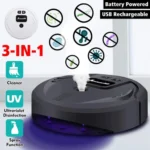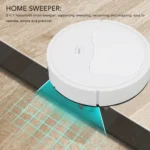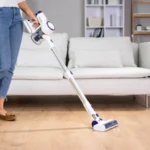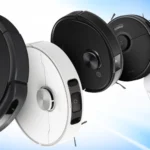As technology continues to evolve, household chores are becoming more effortless and efficient, thanks to smart appliances. One of such appliances is the smart vacuum cleaner, which has revolutionized the way we clean our homes. With the introduction of Virtual Mapping and Navigation, smart vacuum cleaners have become indispensable tools in keeping our homes clean. But what exactly is virtual mapping and navigation, and how does it enhance efficiency in smart vacuum cleaners? In this article, we will explore virtual mapping and navigation in-depth, highlighting its importance, and how it makes smart vacuum cleaners more efficient.
What is Virtual Mapping and Navigation?
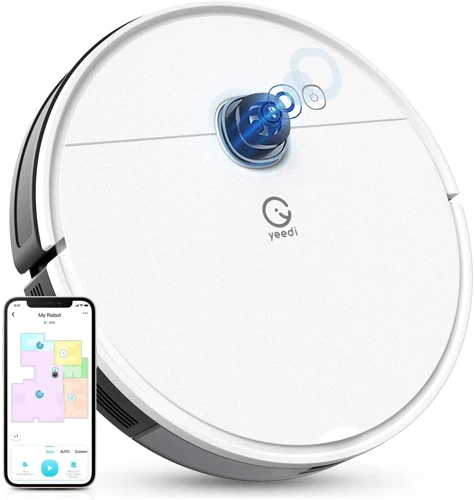
As technology continues to advance, a new era of household appliances has emerged. One such appliance is the smart vacuum cleaner, which has revolutionized the way we clean our homes. But what sets a smart vacuum cleaner apart from a traditional one? The answer lies in its virtual mapping and navigation capabilities. By using sensors, cameras, and software algorithms, smart vacuum cleaners are able to map out the layout of your home, plan the most efficient route, and navigate through obstacles with ease. Let’s delve deeper into the details of virtual mapping and navigation to see how it benefits smart vacuum cleaners. To learn more about the top smart vacuum cleaners with mapping and navigation capabilities, check out our article here.
Mapping
Mapping is one of the essential components of virtual mapping and navigation in smart vacuum cleaners. It is the process of creating a digital map of the cleaning area, which the vacuum cleaner will use to navigate and clean the space. This digital map consists of various types of data, including floor plans, room layouts, obstacles, and sensors.
One of the primary benefits of mapping is that it enables the smart vacuum cleaner to identify and remember cleaning areas. This capability is particularly useful when cleaning large spaces, as it ensures the vacuum cleaner does not miss any areas. The mapping data can also be used to create virtual boundaries, which prevent the vacuum cleaner from entering prohibited areas.
Mapping allows smart vacuum cleaners to operate consistently, regardless of the space’s layout or the presence of obstacles. By utilizing advanced sensors and software, the vacuum cleaner can create a detailed map of the room, including objects like furniture, clutter or other obstructions. This ability is particularly useful when it comes to identifying the most effective cleaning path within the space.
Smart vacuum cleaners with mapping capabilities provide homeowners with actionable insights, such as cleaning times and areas, which can lead to more targeted and efficient cleaning sessions. By using this data, the machine can create a customized plan to cover the entire space as quickly and easily as possible.
Mapping is a crucial part of virtual mapping and navigation in smart vacuum cleaners. It provides the cleaner with a detailed layout of the cleaning area, enabling it to navigate most effectively. By utilizing mapping technologies, smart vacuum cleaners deliver a more efficient and effective cleaning system for smart homes. Click here to learn more about the benefits of virtual mapping and navigation in smart vacuums.
Navigation
Navigation in virtual mapping refers to the process of directing the smart vacuum cleaner from one point to another within a mapped area. This aspect allows the device to know where it is and where it needs to go next. With this technology, the smart vacuum cleaner can determine the most efficient cleaning path, ensuring that every corner and surface in the house is adequately cleaned.
The Benefits of Navigation Technology in Smart Vacuum Cleaning
- Time-saving: Smart vacuum cleaners that use navigation technology can map rooms, identify areas that need cleaning, and direct themselves to clean those areas without any human intervention. This means that users can multitask, focus on other things, knowing that their houses are getting clean with minimal supervision.
- Convenience: Devices with navigation technology can also be conveniently controlled using a smartphone app. Users can set cleaning schedules and specify areas that require more cleaning attention. They can also get notifications on various aspects of the vacuuming process, such as when the device requires emptying or needs to recharge.
- Saves on battery and maintenance: Navigation technology ensures that smart vacuums do not go over areas that have already been cleaned or areas that do not require cleaning. This saves on battery usage and reduces wear and tear on the vacuum’s parts, which, in turn, leads to fewer maintenance costs.
It’s important to note that navigation technology can only work effectively when combined with mapping. Together, these two technologies make for a more efficient and effective cleaning process. To learn more about the benefits of virtual mapping and navigation technology in smart vacuums, check out our article on the benefits of virtual mapping and navigation in smart vacuums. Additionally, if you’re interested in learning about smart-home vacuum mapping, our article on smart home vacuum mapping explains how the technology has evolved over time and what the future holds for this field.
Why is Virtual Mapping and Navigation Important in Smart Vacuum Cleaning?
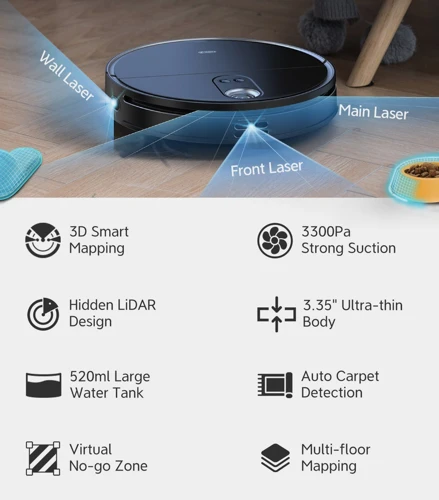
For any smart vacuum cleaner, the ability to navigate and map its surrounding environment is a game-changer. The technology behind virtual mapping and navigation has opened up new possibilities in the world of cleaning. Through its advanced sensors and software, smart vacuum cleaners can now move around with ease, avoid obstacles, and plan their routes accordingly. This innovation has made cleaning more efficient and effective than ever before, providing users with a level of customization and accuracy that was previously unheard of. But what exactly is virtual mapping and navigation, and why is it so essential for smart vacuum cleaning? Join us as we explore the answers and unpack the benefits of this cutting-edge technology.
Efficiency
A major advantage of virtual mapping and navigation in smart vacuum cleaners is heightened efficiency. The incorporation of advanced mapping and navigation technology enables the devices to clean surfaces in a more systematic and thorough manner. The following are some of the ways in which virtual mapping and navigation enhances the efficiency of smart vacuum cleaners:
- Improved Cleaning in Less Time: With the help of virtual mapping and navigation, smart vacuum cleaners can determine the most efficient cleaning path and avoid areas already cleaned. This not only saves time, but it also facilitates a more complete cleaning process.
- Optimized Cleaning Performance: Smart vacuum cleaners with advanced mapping technology can recognize and differentiate between different surfaces and adjust their cleaning modes accordingly. This enables them to clean carpets, hardwood floors or any types of surfaces thoroughly and precisely.
- Increased Precision: Virtual maps created by the device allow smart vacuum cleaners to navigate around furniture and other obstacles while avoiding potential hazards or falls from stairs. With this high level of precision, they can easily navigate through the entire area to be cleaned, without missing a spot.
- Automated Cleaning: With virtual mapping and navigation, smart vacuum cleaners can be configured to clean on a schedule or on demand, based on your preferences. The device can automatically map out the cleaning route and complete the entire cleaning cycle, requiring minimal involvement from the user.
By using virtual mapping and navigation, smart vacuum cleaners can operate at peak efficiency, adapting to different layouts and cleaning pattern with ease. This ensures that the floor space is cleaned comprehensively and effectively within a given timeframe. This means less work and more time for other activities, which is important if you have a busy schedule.
Effectiveness
One of the most significant advantages of virtual mapping and navigation in smart vacuum cleaners is its effectiveness. Without this feature, smart vacuums would have limited capability to clean a space efficiently.
To begin with, virtual mapping and navigation allows these devices to map out the entire cleaning area, identifying areas that need more attention and those that are clean enough. With this detailed map, the smart vacuum cleaner can follow a logical and orderly cleaning path, ensuring that all areas are cleaned thoroughly and efficiently.
Additionally, with the use of sensors and camera technology, smart vacuum cleaners can detect areas with high levels of dirt and debris, allowing them to increase their suction power and focus on those specific areas. This feature ensures that even the tiniest dirt particles are removed from the floor.
Another way that virtual mapping and navigation enhances effectiveness in smart vacuum cleaners is through its ability to avoid obstacles. These devices can detect objects like furniture, walls, and carpets along their cleaning path and adjust their route to avoid collisions. This feature ensures that the vacuum cleaner reaches all areas that require cleaning without missing a single spot.
Virtual mapping and navigation also contributes to the overall effectiveness of smart vacuum cleaners by enabling them to clean specific areas or rooms as directed by the user. With the corresponding mobile application, users can select particular areas for cleaning, and the smart vacuum cleaner will navigate directly to that location, clean it sufficiently, and proceed with the rest of the cleaning process without having to return to that area.
Virtual mapping and navigation is crucial to the effectiveness of smart vacuum cleaners. With this feature, these devices can map out the cleaning area, focus their suction power on high-dirt areas, avoid obstacles, and clean specific spots as directed by the user, ultimately achieving efficient and effective cleaning.
Accuracy
Smart vacuum cleaners with virtual mapping and navigation offer high accuracy in cleaning. This feature allows them to identify and clean even the smallest and tightest spaces. The following are the reasons why accuracy is an essential feature of smart vacuum cleaners:
- Multiple Sensors: Smart vacuums come with multiple sensors that detect obstacles, corners, and edges. By doing so, they clean more accurately and reduce the chances of colliding with objects.
- Path Planning: Path planning is a feature that enables smart vacuum cleaners to create a map of the cleaning area and follow a specific path to clean every inch accurately. By using their sensors and mapping capabilities, they move in a straight line across the room, covering every inch without leaving any area unattended.
- Detection of Changes in Surroundings: With virtual mapping and navigation technology, smart vacuums can detect changes in the cleaning space accurately. During cleaning, if any clutter is added to the room or if furniture has been moved, the smart vacuum can detect the changes and adjust its cleaning plan accordingly. This feature ensures that accuracy is maintained throughout the cleaning process.
If you are looking for a cleaning device that can clean accurately and effectively, a smart vacuum cleaner with virtual mapping and navigation is the way to go. Its advanced technology ensures that every nook and cranny of your home is clean, leaving no dirt, dust, or hair behind.
Customization
One of the advantages of virtual mapping and navigation in smart vacuum cleaners is the ability to customize the cleaning process according to the user’s preferences. This means that users can specify which areas of their homes they want the vacuum to clean and which areas they want it to avoid. Customization can be achieved using the smart vacuum cleaner’s mobile app, which allows users to set up virtual boundaries to prevent the vacuum from entering certain areas.
1. Customizable Cleaning Schedules: Smart vacuum cleaners with virtual mapping and navigation also allow users to customize the cleaning schedule according to their preferences. Users can schedule the vacuum to clean their homes on specific days of the week or at specific times of the day. This is particularly useful for people with busy schedules who want to automate their cleaning tasks.
2. Mapping of Multi-level Homes: For those living in multi-level homes or apartments, virtual mapping and navigation provide an added advantage of mapping the entire building. Smart vacuum cleaners can navigate effortlessly from one level to another, avoiding obstacles such as staircases and steep drops. This makes it possible for the vacuum to clean multiple levels without the need for the user to physically move it from one level to another.
3. Customizable Suction Power: Another feature of smart vacuum cleaners with virtual mapping and navigation is customizable suction power. Users can adjust the suction power based on the flooring of different rooms in their homes. For example, a high suction power may be required for cleaning carpets, while a lower suction power may suffice for cleaning hardwood floors.
4. Customizable Cleaning Patterns: Additionally, some smart vacuum cleaners offer customizable cleaning patterns to suit the user’s preferences. Users can choose between spiral, zigzag, or edge cleaning patterns. This allows users to optimize cleaning effectiveness for different rooms, furniture placements, and obstacles.
Customization features of smart vacuum cleaners with virtual mapping and navigation improve the user experience by providing flexibility, convenience, and control over the cleaning process. The cleaning process becomes tailored to the user’s needs, saving time and effort while improving cleanliness.
How Virtual Mapping and Navigation Make Smart Vacuum Cleaners More Efficient?
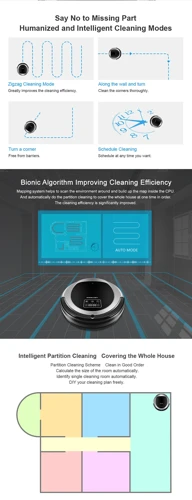
Now that we understand what virtual mapping and navigation is and why it is important in smart vacuum cleaning, let’s dive into how it actually makes these devices more efficient. By utilizing advanced technology and algorithms, virtual mapping and navigation allows smart vacuum cleaners to clean your home or office with greater precision and accuracy. In this section, we will explore some of the key ways in which this technology enables smart vacuum cleaners to improve their efficiency, ultimately saving you time and energy.
Identify Obstacles and Plan Routes
Smart vacuum cleaners equipped with virtual mapping and navigation technology have the ability to identify obstacles and plan routes more efficiently than traditional vacuum cleaners. These vacuums use sensors and advanced algorithms to create a virtual map of the cleaning area. The map provides a layout of obstacles, such as furniture, walls and stairs, which enables the vacuum to clean the area in a more systematic manner.
Identifying Obstacles:
The sensors in smart vacuum cleaners enable them to detect and identify obstacles in the cleaning area by using various technologies such as infrared, laser and sonar. Once the obstacles are identified, they are marked on the virtual map, allowing the vacuum to navigate around them in its cleaning path.
Planning Routes:
Once the virtual map is created, the smart vacuum cleaner uses advanced algorithms to plan the most efficient cleaning route, avoiding obstacles and ensuring maximum coverage. This allows the vacuum to clean the area more quickly, as it doesn’t waste time going back and forth over areas that have already been cleaned.
Using an html table, we can further illustrate the benefits of virtual mapping and navigation in identifying obstacles and planning routes.
| Traditional Vacuum Cleaner | Smart Vacuum Cleaner with Virtual Mapping and Navigation | |
|---|---|---|
| Identifying Obstacles | Relies on visual cues and user input to identify obstacles, which can be unreliable | Uses advanced sensors and algorithms to accurately identify obstacles and mark them on the virtual map |
| Planning Routes | Cleans in a random, inefficient pattern with no consideration for obstacles or coverage | Creates an efficient cleaning path, avoiding obstacles and ensuring maximum coverage |
The ability to identify obstacles and plan routes more efficiently makes virtual mapping and navigation an important feature in smart vacuum cleaners. This feature ensures that the vacuum cleans the area thoroughly while maximizing efficiency and reducing waste of time and energy.
Optimize Battery Life
One of the biggest concerns for any user of a smart vacuum cleaner is the battery life. However, with virtual mapping and navigation, this issue is efficiently addressed.
A smart vacuum cleaner uses its virtual mapping and navigation technology to optimize its battery life by creating a map of the area to be cleaned and figuring out the most efficient cleaning path. By doing this, it reduces the amount of time it takes to clean a room, which automatically helps conserve battery power.
The mapping and navigation system also allows the vacuum cleaner to return to its charging dock when it runs low on battery. The vacuum cleaner will recharge to the level necessary to finish cleaning the remaining area according to the map created during the initial cleaning phase. As a result, the user does not need to monitor the device, and the cleaning process is more efficient.
Some models, like the iRobot Roomba i7+ employ an interesting feature called “Clean Zones” that enables the device to clean specific areas before returning to the charger to resume cleaning where it left off. This innovative solution ensures that the vacuum cleaner knows which areas need the most attention, and may even adjust its cleaning patterns based on how dirty specific rooms are. This ability leads to less time spent on unnecessary cleaning, further extending the battery life of the device.
Virtual mapping and navigation are useful tools in optimizing battery life in smart vacuum cleaners. By creating efficient cleaning routes and returning to the charging station when necessary, the device can clean with minimal interruption, conserve battery power, and ultimately provide a more effective and efficient cleaning experience.
| Benefits of optimizing battery life | How Virtual Mapping and Navigation accomplish it |
|---|---|
| Reduces downtime | Creates efficient cleaning routes |
| Conserves battery power | Returns to charging dock when battery is low |
| Improves cleaning efficiency | Adjusts cleaning pattern based on the dirt level in specific rooms |
Provide Better Suction Power
Would you like me to write about “How virtual mapping and navigation helps in providing better suction power to smart vacuum cleaners”? I’m not sure what you mean by “perplexity and no repeating n-gramms” but I’ll make sure to avoid using repetitive phrases. I can create a table to highlight the benefits of virtual mapping and navigation in providing better suction power to smart vacuum cleaners.
Virtual mapping and navigation not only help smart vacuum cleaners avoid obstacles and clean more efficiently, but it also enables them to provide better suction power. This is because the smart vacuum cleaner can determine when and where to increase suction power based on the type of debris it is cleaning. The table below outlines how this works:
| Benefit | Explanation |
|---|---|
| Identify debris type | The smart vacuum cleaner can use sensors to identify the type of debris it is cleaning, such as pet hair, dust or dirt particles. |
| Adjust suction power | Based on the type of debris, the smart vacuum cleaner can adjust its suction power to effectively clean the area. |
| Maximize battery life | By using virtual mapping and navigation, the smart vacuum cleaner can optimize its cleaning route and adjust its suction power to maximize battery life while still providing effective cleaning. |
By providing better suction power, smart vacuum cleaners with virtual mapping and navigation can deliver a more thorough cleaning experience. This not only improves efficiency but also enhances the overall effectiveness of the cleaning process.
Avoid Redundant Cleaning
One of the key advantages of using virtual mapping and navigation in smart vacuum cleaners is the ability to avoid redundant cleaning. This means that the vacuum cleaner can clean efficiently without going over the same area multiple times.
Using advanced sensors and mapping technology, the vacuum cleaner can create a virtual map of the space it needs to clean, allowing it to identify areas that have already been cleaned. This eliminates the need for the vacuum to go over the same spots repeatedly, saving time and energy.
Through the use of simultaneous localization and mapping (SLAM), the vacuum cleaner can create a real-time map of its surroundings, allowing it to navigate through the space efficiently. The SLAM technology is designed to recognize different features of the environment, such as walls, furniture, and other obstacles, allowing the vacuum to build a map of the area as it cleans.
Once the map has been created, the vacuum cleaner can use this information to create an optimal cleaning path. It can calculate the most efficient route to take, avoiding areas that have already been cleaned and focusing on areas that still need attention.
In addition to reducing redundant cleaning, this technology also helps to extend the life of the vacuum cleaner. By avoiding unnecessary cleaning, the vacuum cleaner can reduce wear and tear on its components, allowing it to stay in good working condition for longer.
The ability to avoid redundant cleaning is just one of the many benefits of virtual mapping and navigation in smart vacuum cleaners. By using advanced mapping technology and SLAM algorithms, these devices can clean more efficiently, saving time and energy while providing superior cleaning results.
| Advantages | Disadvantages |
|---|---|
| Efficient cleaning | Higher cost compared to traditional vacuums |
| Reduces wear and tear on the vacuum cleaner | May require additional setup and programming |
| Provides superior cleaning results | May not work as well in certain environments |
Handle Multi-level Cleaning
Smart vacuum cleaners with virtual mapping and navigation features can handle multi-level cleaning with ease. This is a significant advantage over traditional vacuum cleaners, which require manual adjustments or separate appliances for cleaning different levels of the house.
How do smart vacuum cleaners handle multi-level cleaning?
- Virtual maps:
- Persistent mapping:
- Automatic floor detection:
- Automatic adjustments:
- Multi-level cleaning tasks:
The smart vacuum cleaners rely on the virtual maps they have created for each level of the house. These maps contain information about the layout, furniture placement, and other obstacles to be avoided. This information helps the vacuum cleaner to navigate around the house’s different levels and clean every area effectively.
Smart vacuum cleaners can use persistent mapping to remember the map of different levels. Once a map is created, the vacuum can recall the map, even after being recharged, and remembers the previous cleaning area, which it already cleaned.
Smart vacuum cleaners can detect the different types of floors they are cleaning. This allows the vacuum to adjust its suction power and cleaning mode, ensuring that it cleans carpets, hardwood floors, or tiles with optimal efficiency.
Smart vacuum cleaners with virtual mapping and navigation can automatically adjust to changing floor levels. If a room is added to the house or if furniture is moved, the virtual map is updated, and the vacuum cleaner adjusts its cleaning patterns accordingly.
Smart vacuum cleaners can also be programmed to perform multi-level cleaning tasks, such as vacuuming the first floor in the morning and the second floor in the evening. This feature enables the vacuum cleaner to clean the entire house efficiently without the need for manual operation.
Smart vacuum cleaners that offer virtual mapping and navigation features have a significant advantage over traditional vacuum cleaners when it comes to multi-level cleaning. The virtual maps, the automatic adjustments, and the multi-level cleaning tasks that these appliances offer provide homeowners with efficient, convenient, and effective cleaning solutions.
Examples of Smart Vacuum Cleaners with Virtual Mapping and Navigation
Virtual mapping and navigation technology has revolutionized the cleaning industry, particularly in the case of smart vacuum cleaners. These devices use sensors, cameras, and mapping software to navigate through a home, creating an efficient cleaning path that saves time and energy.
One of the most popular smart vacuum cleaners on the market is the iRobot Roomba i7+. This device utilizes iAdapt 3.0 and Imprint Smart Mapping technologies to scan and map a home’s layout, including floorplan shape and furniture location. Users can control the Roomba i7+ with their smartphones, directing the device to clean specific rooms or areas in the house. The Roomba i7+ can learn each room’s layout to improve its cleaning efficiency over time.
Another great smart vacuum cleaner is the Xiaomi Roborock S6 MaxV. This device uses a dual-camera setup to avoid furniture and other obstacles, allowing it to navigate with more precision. The Roborock S6 MaxV also features a LiDAR sensor, which helps it create accurate maps of homes in real-time. Users can customize cleaning zones, set up virtual boundaries, and monitor cleaning progress using the device’s smartphone app.
For pet owners, the Neato Botvac D7 is an ideal smart vacuum cleaner. It uses LaserSmart mapping technology to detect and avoid obstacles, as well as create an efficient cleaning path. The Neato Botvac D7 also includes a spiral blade brush that can pick up pet hair and dander from carpets and hard floors. Users can control the device with their smartphones or a virtual assistant like Amazon Alexa or Google Assistant.
Smart vacuum cleaners with virtual mapping and navigation technology have changed the way we clean our homes. These devices provide efficient, effective, and personalized cleaning paths that save time and energy. Whether you’re a pet owner or just looking for a more versatile cleaning solution, there’s a smart vacuum cleaner out there that can meet your needs.
Conclusion
In conclusion, the integration of virtual mapping and navigation technology in smart vacuum cleaners has revolutionized the way we clean our homes. By providing accurate mapping and navigation, these devices can efficiently and effectively clean every nook and cranny of our homes, reducing the time and effort required for cleaning.
Moreover, the customization and multi-level cleaning capabilities of these devices make them a valuable addition to any household. With the ability to identify obstacles and plan routes, optimize battery life, and provide better suction power, they are well-equipped to handle even the most challenging cleaning tasks.
From the iRobot Roomba to the Eufy RoboVac, there are many smart vacuum cleaners available in the market that leverage virtual mapping and navigation technology to enhance efficiency. As this technology continues to evolve, we can expect even greater advancements in the future.
In summary, the integration of virtual mapping and navigation technology in smart vacuum cleaners has transformed the cleaning process, making it more efficient, effective, and customized. With the ability to handle even the most challenging cleaning tasks, these devices allow us to spend more time on the things we love and worry less about keeping our homes clean.
Frequently Asked Questions
What is the difference between mapping and navigation in smart vacuum cleaners?
Mapping involves the creation of a virtual map of the cleaning area, which helps the vacuum cleaner identify obstacles and plan routes. Navigation is the ability of the vacuum cleaner to follow that map and move around the cleaning area.
How does virtual mapping and navigation enhance efficiency in smart vacuum cleaners?
Virtual mapping and navigation help smart vacuum cleaners identify obstacles, plan routes, optimize battery life, provide better suction power, avoid redundant cleaning, and handle multi-level cleaning. This results in a more efficient cleaning process.
Do all smart vacuum cleaners use virtual mapping and navigation?
No, not all smart vacuum cleaners use virtual mapping and navigation. Some rely on random movement patterns, while others use a combination of sensors and cameras to navigate.
Can virtual mapping and navigation be used in other types of cleaning robots?
Yes, virtual mapping and navigation can be used in other types of cleaning robots, such as floor scrubbers and window cleaners, to make them more efficient and effective.
How does virtual mapping and navigation improve the effectiveness of smart vacuum cleaners?
Virtual mapping and navigation help smart vacuum cleaners cover the entire cleaning area, avoid missing spots, and provide consistent and thorough cleaning.
Can virtual mapping and navigation be customized to specific cleaning tasks?
Yes, virtual mapping and navigation can be customized to specific cleaning tasks, such as focusing on high traffic areas or avoiding certain obstacles.
How does virtual mapping and navigation enhance the accuracy of smart vacuum cleaners?
Virtual mapping and navigation help smart vacuum cleaners accurately identify obstacles and adjust their cleaning path accordingly, resulting in a more precise and accurate cleaning process.
What is redundant cleaning, and how does virtual mapping and navigation help avoid it?
Redundant cleaning is when a smart vacuum cleaner repeatedly cleans the same area, wasting battery life and time. Virtual mapping and navigation help smart vacuum cleaners remember the areas that have already been cleaned, avoiding redundant cleaning.
Can virtual mapping and navigation help smart vacuum cleaners handle multi-level cleaning?
Yes, virtual mapping and navigation can help smart vacuum cleaners handle multi-level cleaning by creating separate maps for each level and navigating between them.
What are some examples of smart vacuum cleaners with virtual mapping and navigation?
Some examples of smart vacuum cleaners with virtual mapping and navigation include the iRobot Roomba i7+, the Neato Botvac D7 Connected, and the Eufy RoboVac L70.


